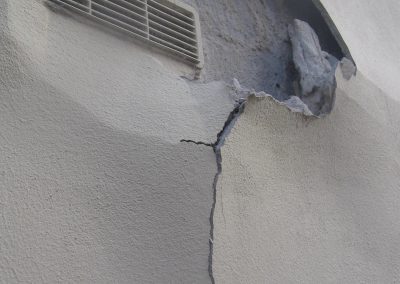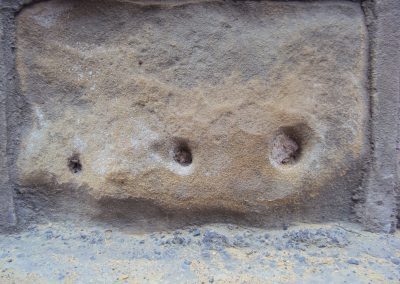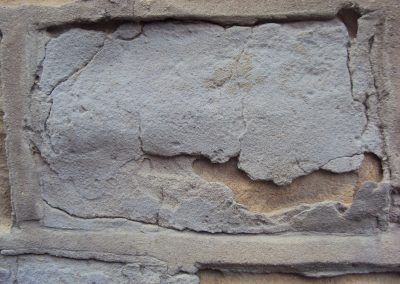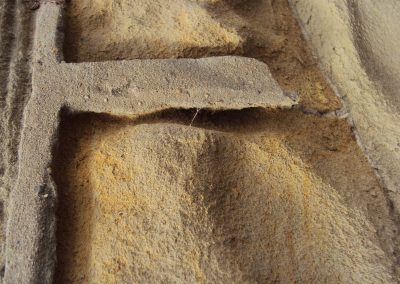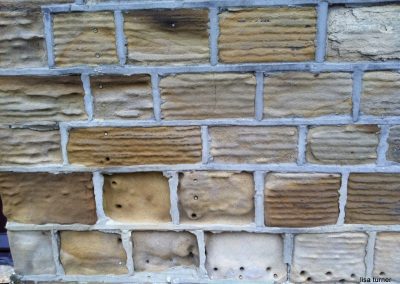Cement Pointing Rendering and the problems they can cause
The risks of using cement materials on old period houses
Below you will see some pictures of the irreparable damage that sand & cement (concrete) pointing and rendering materials can do to old solid walls (stone or brick) Pointing or rendering materials that are cementitious based can generally be too hard for the masonry of old solid wall buildings.
Cement pointing material has the tendency to squeeze moisture into the surrounding stone or brickwork, more so if they contain additives such as integral water-proofing agents, latex or PVA. When old houses were built the lime mortar they were constructed with lime to bond the brick or stonework together, the exposed outside facing mortar (the pointing) was designed to be sacrificial in other words the lime pointing would, over a long time weather away and need some attention but the stone or brickwork would be saved from the crumbling effects of water and freeze-thaw damage (spalling)
Unlike Cement pointing and renders, good quality lime mortars have some flexibility
Lime pointing or renders weather well even after years of sun, rain, frost etc. Due in part to the fact that the lime pointing material is able to move with the building.The main benefits of lime mortars for rendering or pointing are the materials ability to resist cracking, coupled with the ability to absorb moisture and its breathability, lime mortar is able to cope with years of whatever mother nature can throw at it. Between wet and dry weather the characteristics of lime mortar allow walls to dry out.
The Mistakes:
Often through ignorance or lack of care, many houses are cement-pointed or rendered with hard mixes of concrete based mortars.
Many homeowners and builders look at the soft lime pointing on a period home and come to the conclusion that it is defective and needs replacing. Usually with the recommendation of a waterproof rock hard cement mortar. This mistake is often made, all because the pointing may be a little soft and chalky. But this is how lime pointing is meant to be. It had the same, softer, malleable characteristics, all those years ago, the day it was built.
As mentioned above the soft lime pointing mix saves the masonry from degradation, sorry but it’s worth mentioning again.
It’s the lime pointing mortar that may suffer from some wear and tear and not the stone or brickwork
Other problems with both lime or cement based mortar mixes can be attributed to the sands that are used. Often the aggregates used are incorrect. They may be too fine, the wrong shape or not washed etc. Using hydraulic lime mortars for external pointing and renders will only work if the correct sands are used. After all, sand is the biggest ingredient of mortar. Some of the lime pointing mortars will have had coal-derived ash added to them, cinder ash was of course in abundance and it made a great pozzolan and binder.
The sand should be sharp, washed & graded and free from impurities such as clays. The shape of the sand particles is very important. Round particles of sand do not bind together well, imagine, trying to glue marbles together. If you smashed them into angular sharp pieces they would bind and hold together much better than round shaped pieces.Many traditional mixes and skills of the old days are lost, but there are still specialist firms around like Back2Brick that can offer expert advice
Other flaws can include the profile and style that the pointing has been finished in. Some patterns can encourage damp and spalling. On stonework, pointing is often finished in a boxed…or strap pointing profile they have small horizontal ledges, this profile can allow water to pond on the surface, it can then harbour moisture inside the wall where it damages the stone or brick even more. When re-pointing on both modern and period houses, often the mortar joints or beds are not chased out deep enough.
The mortar beds should be carefully raked back to avoid damage, deep enough for the pointing material to sit in. Once the initial set of the mortar has taken place the joints should be compacted with a jointer or other tool. If the pointing material has been applied too thinly the first few touches of frost will eject it off the wall, making it useless.
Back2Brick are able to specify pointing for both cavity and solid walls, using modern injection or traditional methods using both cement or lime-based mortars.
If you are researching what the best materials and techniques are for re-pointing or rendering the old solid walls of your home why not arrange to have a professional survey conducted?
Our expert surveying service could save you both time and money, it could also prevent possible damage to your home. Below are some pictures illustrating the irreversible effects that incorrect cement pointing materials can have on old solid walls. For more information on the preservation of older period houses, we suggest you visit the excellent & impartial site of the Society for the Protection of Ancient Buildings: SPAB

